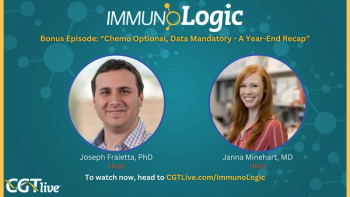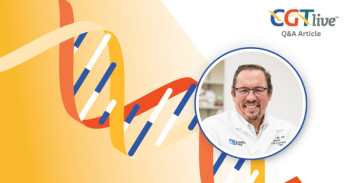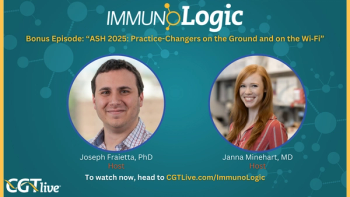
CD19-Targeted CAR T-Cell Therapies Induce Durable Remissions in Several Lymphoma Subtypes
CD19-targeted CAR T-cell therapies have yielded durable remissions in approximately half of all patients with aggressive relapsed/refractory B-cell lymphomas.
CD19-targeted CAR T-cell therapies have yielded durable remissions in approximately half of all patients with aggressive relapsed/refractory B-cell lymphomas, Caron Jacobson, MD, MMSc, said during a presentation during the
“Across the globe, CAR T trials are expanding exponentially. The field is growing beyond hematologic malignancies and [evaluating these products in] solid tumors,” said Jacobson, who is an assistant professor of medicine at Harvard Medical School, as well as the medical director of the Immune Effector Cell Therapy Program at the Dana-Farber Cancer Institute. “I want to remind everyone that targeting CD19 with CAR T-cell therapy has led to durable remissions in 40% to 50% of patients with aggressive B-cell non-Hodgkin lymphoma, leading to FDA approvals in diffuse large B-cell lymphoma [DLBCL], high-grade B-cell lymphoma, transformed follicular lymphoma, and primary mediastinal B-cell lymphoma in the third-line [setting] and beyond.”
The encouraging responses observed in patients with large B-cell lymphoma (LBCL) have been reported in several studies. For example, in the phase 1/2 ZUMA-1 trial (NCT02348216), axicabtagene ciloleucel (axi-cel; Yescarta) elicited a complete response (CR) rate of 54%, with 40% of patients maintaining a CR at a median follow-up of 15.4 months.2 Similarly, in the phase 2 JULIET study (NCT02445248), tisagenlecleucel (tisa-cel; Kymriah) yielded a CR rate of 40%, with an estimated relapse-free survival rate of 65%.3 Additionally, in the phase 1 TRANSCEND NHL 001 trial (NCT02631044), lisocabtagene maraleucel (liso-cel; Breyanzi) elicited a 53% CR rate in this patient population.4
A recent update from ZUMA-1, which was presented during the
In the phase 2 ZUMA-12 trial (NCT03761056), investigators are evaluating the use of axi-cel as a first-line treatment in patients with high-risk LBCL.6 Early data from the interim analysis of the trial showed that the CAR T-cell product elicited an overall response rate (ORR) of 85%, which included a CR rate of 74%. These responses are even higher than what has been observed in patients who receive CAR T-cell therapy in later-line settings, Jacobson noted.
Efficacy Gains Observed in Other Lymphomas Subtypes
CAR T-cell therapy has shown similar promise in patients with other lymphoma subtypes, such as MCL. Brexucabtagene autoleucel (brexu-cel; Tecartus)
“[At] an average of 17.5 months of follow-up, about 60% of patients maintained their response,” Jacobson said.
Similar benefit was seen in patients with MCL who were treated with liso-cel in TRANSCEND NHL 001. Here, the CAR T-cell product yielded an ORR of 84% (95% CI, 67%-95%), which included a CR rate of 66% and a PR rate of 19%.9 However, the follow-up on this study was relatively short at a median of 5.9 months (range, 0.4-24.8), meaning more mature data are needed to understand response durability, Jacobson added.
In the phase 2 ZUMA-5 study (NCT03105336), patients with follicular lymphoma or marginal cell lymphoma (MZL) who had relapsed/refractory disease following at least 2 lines of therapy received axi-cel.10 The overall patient population experienced an ORR of 92% with the CAR T-cell product, which included a CR rate of 76%. Patients with follicular lymphoma had an ORR of 94% and a CR rate 80%, and patients with MZL had an ORR of 95% and a CR rate of 60%.
“Seventy to 80% of patients maintained their response for that time point,” Jacobson said. “In a disease such as follicular lymphoma, we need a very long follow-up to understand how a therapy like this is transforming the natural history of this disease. Remember, these patients were treated in the third line and beyond with existing therapies such as PI3K inhibitors [and have] a median progression-free survival of 10 to 13 months.”
Additionally, tisa-cel demonstrated very promising results in the phase 2 ELARA study (NCT03568461) when evaluated in patients with relapsed/refractory follicular lymphoma, according to Jacobson.11 After a median follow-up of 10 months, patients who received the CAR T-cell therapy experienced an ORR of 82.7%, which included a CR rate of 65.4% and a PR rate of 17.3%. The median duration of response had not yet been reached.
There is also reason to believe that CAR T-cell therapy could have a place in the Hodgkin lymphoma treatment paradigm.
“We have heard over the past several years about CD30-directed CAR T cells from Baylor University and the University of North Carolina to treat [patients with] Hodgkin lymphoma,” Jacobson said. “Based on their phase 1 experience where 41 [heavily pretreated] patients… [ were given] fludarabine-based lymphodepletion, we’re seeing ORRs as high as 72% and CR rates as high as 60% in multiply-relapsed [patients with] classic Hodgkin lymphoma.”12
Managing Toxicities Associated With CAR T-Cell Therapy
The primary toxicities associated with CAR T-cell therapy are cytokine release syndrome (CRS) and neurotoxicities. Grade 3 CRS, which can lead to for intensive care unit intervention, occurs slightly more often in patients who receive CD28-targeted CAR T-cell therapies such as axi-cel (13%) and brexu-cel (15%) compared with 4-1BB CAR T-cell products like liso-cel (2%), according to Jacobson. Additionally, CD28-targeted products tend to have higher rates of grade 3 or higher neurotoxicity, as has been seen with axi-cel (28%) and brexu-cel (31%). By comparison, tisa-cel (12%) and liso-cel (10%) have shown lower rates of CRS.
“If you compare the results of the ZUMA-5 study with the ZUMA-1 study, you can see a lower rate of grade 3 or higher CRS, as well as neurologic toxicity,” said Jacobson. “When you compare the ELARA study with the JULIET study, looking at the same product in a different indication, you’re also seeing an improvement in rates of grade 3 or higher CRS and neurologic toxicity.”
Additionally, Jacobson noted that there have been many inconsistencies with how toxicity associated with CAR T-cell therapy is graded across different studies and institutions. As such, the American Society for Transplantation and Cellular Therapy developed a new grading system that can be used in future clinical trials.
The grading system defines grade 1 CRS as having a fever of 38.5 degrees C or higher, while grade 2 is defined as having a fever plus hypotension that does not require vasopressors and/or hypoxia requiring low-flow oxygen. Grade 3 CRS is now defined as fever as well as hypotension that requires a vasopressor and/or hypoxia requiring high-flow oxygen with a face mask or non-rebreather mask. Lastly, grade 4 CRS can be identified by fever, and hypotension requiring multiple vasopressors and/or hypoxia requiring positive pressure ventilation.
Moreover, the new guidelines incorporate a mental status score known as the ICE score, coupled with measurements of arousal and imaging in order to measure severity of immune effector cell–associated neurotoxicity syndrome.
Looking to the Future
The field has seen some emerging data for dual antigen–targeted CAR T-cell therapies, which target CD19 and an additional antitumor antigen. In a phase 1 study, a CAR T-cell product that targeted CD19 and CD20 4-1BBz elicited an ORR of 82% and a CR rate of 64% in patients with DLBCL.13
“The same product was used in a multicenter study in Europe and presented at [the 2020] ASH [Annual Meeting & Exposition],” Jacobson said. “The turnaround time for these CAR T cells was 14 days and only 12 patients were treated, but you can see response rates were 75% and CR rates were 42%. …These numbers are not so much better than what we’re seeing with single-antigen CD19 CARs. Maybe dual-antigen CARs aren’t the [complete] answer.”
Jacobson also spoke about the growing understanding regarding neurotoxicity in patients with lymphoma who are treated with CAR T-cell therapies. Ongoing clinical trials exploring different inhibitor molecules and cytokine molecules to prevent and treat neurological toxicities, should they develop, Jacobson concluded.
References
- Jacobson C. Updates on CAR T-cells in lymphoma. Presented at: 25th Annual International Congress on Hematologic Malignancies; February 25-28, 2021; Virtual. Accessed February 25, 2021.
- Neelapu SS, Locke Fl, Bartlett NL, et al. Axicabtagene ciloleucel CAR T-cell therapy in refractory large B-cell lymphoma. N Engl J Med. 2017;377(26):2531-2544. doi:10.1056/NEJMoa1707447
- Schuster SJ, Bishop MR, Tam CS, et al. Tisagenlecleucel in adult relapsed or refractory diffuse large B-cell lymphoma. N Engl J Med. 2019;380(1):45-56. doi:10.1056/NEJMoa1804980
- Abramson JS, Palomba ML, Gordon LI, et al. Lisocabtagene maraleucel for patients with relapsed or refractory large B-cell lymphomas (TRANSCEND NHL 001): a multicentre seamless design study. Lancet. 2020;396(10254):839-852. doi:10.1016/S0140-6736(20)31366-0
- Jacobson C, Lock FL, Ghobadi A, et al. Long-term survival and gradual recovery of B cells in patients with refractory large B cell lymphoma treated with axicabtagene ciloleucel (Axi-Cel). Paper presented at: 62nd ASH Annual Meeting and Exposition; December 5-8, 2020; Virtual. Accessed February 25, 2021. Abstract 1187.
http://bit.ly/2Nvt7y9 - Neelapu SS, Dickinson M, Munoz J, et al. Interim analysis of ZUMA-12: a phase 2 study of axicabtagene ciloleucel (axi-cel) as first-line therapy in patients with high-risk large B-cell lymphoma. Presented at: 2021 Transplantation & Cellular Therapy Meetings; February 8-12, 2021; Virtual.
http://bit.ly/3bJv8i4 - US FDA approves Kite’s Tecartus, the first and only CAR T treatment for relapsed or refractory mantle cell lymphoma. News release. Gilead. Published July 24, 2020. Accessed February 25, 2021.
https://bit.ly/2ZVy6v9 - Wang M, Munoz J, Goy A, et al. KTE-X19 CAR T-cell therapy in relapsed or refractory mantle-cell lymphoma. N Engl J Med. 2020;382(14):1331-1342. doi:10.1056/NEJMoa1914347
- Palomba ML, Gordon LI, Siddiqi T, et al. Safety and preliminary efficacy in patients with relapsed/refractory mantle cell lymphoma receiving lisocabtagene maraleucel in Transcend NHL 001. Blood. 2020;136(suppl 1):10-11. doi:10.1182/blood-2020-136158
- Jacobson C, Chavez JC, Sehgal AR, et al. Primary analysis of Zuma-5: A phase 2 study of axicabtagene ciloleucel (axi-cel) in patients with relapsed/refractory (R/R) indolent non-Hodgkin lymphoma (iNHL). Blood. 2020;136(suppl 1):40-41. doi:10.1182/blood-2020-136834
- Fowler NH, Dickinson M, Dreyling M, et al. Efficacy and safety of tisagenlecleucel in adult patients with relapsed/refractory follicular lymphoma: interim analysis of the phase 2 ELARA trial. Blood. 2020;1336(suppl 1):1-3. doi:10.1182/blood-2020-138983
- Ramos CA, Grover NS, Beaven AW, et al. Anti-CD30 CAR-T cell therapy in relapsed and refractory Hodgkin lymphoma. J Clin Oncol. 2020;38(suppl 32):3794-3804. doi:10.1200/JCO.20.01342
- Shah NN, Zhu F, Schneider D, et al. Results of a phase I study of bispecific anti-CD19, anti-CD20 chimeric antigen receptor (CAR) modified T cells for relapsed, refractory, non-Hodgkin lymphoma. J Clin Oncol. 2019;37(suppl 15):2510-2510. doi:10.1200/JCO.2019.37.15_suppl.2510
Newsletter
Stay at the forefront of cutting-edge science with CGT—your direct line to expert insights, breakthrough data, and real-time coverage of the latest advancements in cell and gene therapy.





































